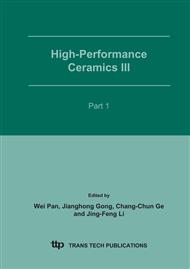p.201
p.205
p.209
p.211
p.215
p.219
p.223
p.227
p.231
Effects of SiO2 Substitution on Piezoelectric and Mechanical Properties of PMS-PZT Ternary Piezoelectric Ceramics
Abstract:
The effects of SiO2 additives on microstructure, piezoelectric and mechanical properties were investigated for Pb0.98Sr0.02(Mn1/3Sb2/3)0.05Zro.48Ti0.47O3 (PMS-PZT) ternary system close to the morphotropic phase boundary. Piezoelectric coefficient (d33) and electromechanical coupling factor (Kp) considerably deteriorated with the substitution of SiO2 increased. On the other hand, the mechanical quality factor (Qm) increased, the maximum value was 1800. Fracture strength of 1.0 wt% SiO2 added the specimens reached to 106.54 MPa which was about 1.4 times higher than pure PMS-PZT ceramic. The rapid improvement of fracture strength probably due to the decrease of grain size, pore distribute and the second phase (redundant Si4+ ions) segregating on the grain boundary which enhanced the bond energy of grain boundary. The optimized concentration of SiO2 doped PMS-PZT ceramics was 0.4 wt% for high power application: d33 = 300 PC/N, Kp = 0.51, Qm = 1500, tand = 0.32% and the fracture strength was 88.5MPa.
Info:
Periodical:
Pages:
215-218
Citation:
Online since:
February 2007
Authors:
Keywords:
Price:
Сopyright:
© 2005 Trans Tech Publications Ltd. All Rights Reserved
Share:
Citation:


